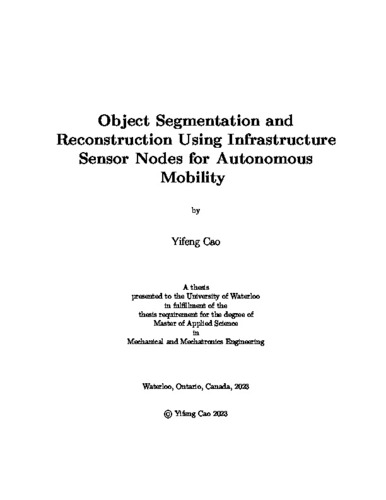| dc.description.abstract | This thesis focuses on the Lidar point cloud processing for the infrastructure sensor node that serves as the perception system for autonomous robots with general mobility in indoor applications. Compared with typical schemes mounting sensors on the robots, the method acquires data from infrastructure sensor nodes, providing a more comprehensive view of the environment, which benefits the robot's navigation. The number of sensors would not need to be increased even for multiple robots, significantly reducing costs. In addition, with a central perception system using the infrastructure sensor nodes navigating every robot, a more comprehensive understanding of the current environment and all the robots' locations can be obtained for the control and operation of the autonomous robots.
For a robot in the detection range of the sensor node, the sensor node can detect and segment obstacles in its driveable area and reconstruct the incomplete, sparse point cloud of objects upon their movement. The complete shape by the reconstruction benefits the localization and path planning which follows the perception part of the robot's system.
Considering the sparse Lidar data and the variety of object categories in the environment, a model-free scheme is selected for object segmentation. Point segmentation starts with background filtering. Considering the complexity of the indoor environment, a depth-matching-based background removal approach is first proposed. However, later tests imply that the method is adequate but not time-efficient. Therefore, based on the depth matching-based method, a process that only focuses on the drive-able area of the robot is proposed, and the computational complexity is significantly reduced. With optimization, the computation time for processing one frame of data can be greatly increased, from 0.2 second by the first approach to 0.01 second by the second approach. After background filtering, the remaining points for occurring objects are segmented as separate clusters using an object clustering algorithm.
With independent clusters of objects, an object tracking algorithm is followed to allocate the point clusters with IDs and arrange the clusters in a time sequence. With a stream of clusters for a specific object in a time sequence, point registration is deployed to aggregate the clusters into a complete shape. And as noticed during the experiment, one of the differences between indoor and outdoor environments is that contact between objects in the indoor environment is much more common. The objects in contact are likely to be segmented as a single cluster by the model-free clustering algorithm, which needs to be avoided in the reconstruction process. Therefore an improvement is made in the tracking algorithm when contact happens. The algorithms in this thesis have been experimentally evaluated and presented. | en |

